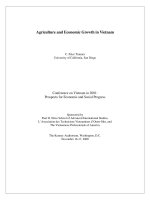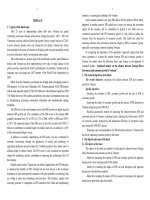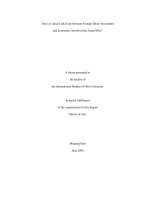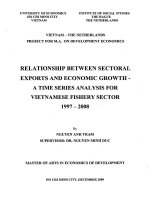Gender and Economic Growth in Kenya
Bạn đang xem bản rút gọn của tài liệu. Xem và tải ngay bản đầy đủ của tài liệu tại đây (1.1 MB, 164 trang )
DIRECTIONS IN DEVELOPMENT
Private Sector Development
Gender and Economic Growth
in Kenya
Unleashing the Power of Women
Gender and Economic Growth in Kenya
Gender and Economic
Growth in Kenya
Unleashing the Power of Women
Amanda Ellis
Jozefina Cutura
Nouma Dione
Ian Gillson
Clare Manuel
Judy Thongori
©2007 The International Bank for Reconstruction and Development / The World Bank
1818 H Street NW
Washington DC 20433
Telephone: 202-473-1000
Internet: www.worldbank.org
E-mail:
All rights reserved
1 2 3 4 5 10 09 08 07
This volume is a product of the staff of the International Bank for Reconstruction and
Development / The World Bank. The findings, interpretations, and conclusions expressed in this
volume do not necessarily reflect the views of the Executive Directors of The World Bank or the
governments they represent.
The World Bank does not guarantee the accuracy of the data included in this work. The boundaries,
colors, denominations, and other information shown on any map in this work do not imply any
judgement on the part of The World Bank concerning the legal status of any territory or the
endorsement or acceptance of such boundaries.
Rights and Permissions
The material in this publication is copyrighted. Copying and/or transmitting portions or all of
this work without permission may be a violation of applicable law. The International Bank for
Reconstruction and Development / The World Bank encourages dissemination of its work and
will normally grant permission to reproduce portions of the work promptly.
For permission to photocopy or reprint any part of this work, please send a request with complete
information to the Copyright Clearance Center Inc., 222 Rosewood Drive, Danvers, MA 01923,
USA; telephone: 978-750-8400; fax: 978-750-4470; Internet: www.copyright.com.
All other queries on rights and licenses, including subsidiary rights, should be addressed to the
Office of the Publisher, The World Bank, 1818 H Street NW, Washington, DC 20433, USA;
fax: 202-522-2422; e-mail:
ISBN-10: 0-8213-6919-9
ISBN-13: 978-0-8213-6919-7
eISBN-10: 0-8213-6920-2
eISBN-13: 978-0-8213-6920-3
DOI: 10.1596/978-0-8213-6919-7
Cover photo: Fabric design by Flotea Massawe, female entrepreneur.
Cover design by Drew Fasick, Serif Design Group.
The World Bank is committed to preserving endangered forests and natural resources. The Office
of the Publisher has chosen to print Gender and Economic Growth in Kenya on recycled paper
with 30 percent postconsumer fiber in accordance with the recommended standards for paper
usage set by the Green Press Initiative, a nonprofit program supporting publishers in using fiber that
is not sourced from endangered forests. For more information, visit www.greenpressinitiative.org.
Library of Congress Cataloging-in-Publication Data
World Bank.
Gender and economic growth in Kenya : unleashing the power of women.
p. cm.
Includes bibliographical references.
ISBN-13: 978-0-8213-6919-7
ISBN-10: 0-8213-6919-9
ISBN-10: 0-8213-6920-2 (electronic)
1. Women—Kenya—Economic conditions. 2. Women in development—Kenya. I. Title.
HQ1381.W665 2007
330.967620082—dc22
2006039772
Contents
Foreword
Acknowledgments
Acronyms and Abbreviations
Overview
Matrix of Recommendations
Chapter 1
xiii
xv
xvii
xxi
xxxi
Overview of Kenya’s Legal Framework
How Does Kenya’s Legal Framework Impact on
Gender Issues?
International Obligations Have Impacted
Little on Domestic Law
Kenya’s Constitution Entrenches Gender Inequality
Kenya’s Statutory Legislation Reflects
This Discriminatory Framework
The Constitution Permits Discriminatory Customary
Law Practices
Government Recognizes the Need to Address
These Barriers
Input into the Private Sector Development
Strategy and Other Initiatives
Note
1
1
1
2
4
4
6
6
7
v
vi
Contents
Chapter 2
Chapter 3
The Gender/Economic Growth Nexus
Women Start from a Disadvantaged Position
Women Predominate in Agriculture, but
Their Contribution Tends to Be Unpaid
Women Are Less Predominant in Formal Sector
Employment and Tend to Have Lower Wages
Kenyan Women Constitute Almost Half of Micro and
Small Business Owners
Women’s Dual Roles and Time Burden Affect
Economic Productivity
Women Are Particularly Impacted by HIV/AIDS
and Are Victims of Gender-Related Violence
Inequalities in Access to Education Have an
Adverse Impact on Growth
Equal Access to Formal Employment and
Agricultural Inputs Positively Impacts
Economic Growth
Notes
Access to Property Rights and Land
Denial of Property Rights in Relation to Land
Impacts on Poverty
The Formal Legal Framework for Land Market
Regulation Is Unsatisfactory, but Does Not
Prevent Women from Owning Land
Women’s Property Rights Are Often through a Man
Formal Statute Law Gives Property Rights to
Married Women
The Married Women’s Property Act of 1882 Gives
Married Women Equal Rights to Own Property
The Law of Succession Act Gives Women
Inheritance Rights
A Cohabiting Woman Has No Rights under Either
the Formal Legal System or Customary Law
It Can Be Difficult to Establish Marital Status
Formal, Established Legal Principles Are
Not Applied in the Vast Majority of Cases
In Practice, Many of Those Dispensing Justice—from
Judges to Chiefs—Are Unaware of
the Legal Position
9
10
10
12
13
13
15
17
18
19
21
22
23
24
25
25
26
28
28
28
29
Contents
Formal Registration Practices Have
Excluded Women
Allocation of State Land Has Excluded Women
Family Land Can Be Disposed of without a
Wife’s Consent
Women Can Be Ineligible for Cooperative
Membership
The Developing National Land Policy Is an
Opportunity for Reform
Recommendations
Notes
Chapter 4
Chapter 5
Access to Finance and Collateral
Access to Affordable Finance Is a Key Constraint
Informal Savings and Microfinance
The “Missing Middle” in Financial Services
The Legal and Regulatory Framework for SME
Finance Is Incomplete
Women Entrepreneurs Are Not Rewarded for
Their Repayment History
Law Reform Could Enable Nonland Assets
to Be Used as Collateral
Recommendations
Notes
Access to the Formal Sector: Business
Entry and Licensing
The Government of Kenya Recognizes the
Importance of the MSME Sector to
Employment Creation and Economic Growth
Yet Many Women Are “Stuck” Running
Micro Enterprises in the Informal Sector
Registration Is an Important Step for
Business Growth
Women May Respond Well to Simplified
Registration Procedures
Registration of Business Names Act: Fundamental
Reform Required
Companies Act Registration: Best-Practice
Business Entry Reform Required
vii
30
31
32
35
35
36
38
41
41
42
44
45
46
47
49
50
51
51
52
52
52
54
57
viii
Contents
Companies Act Registration Facilitates the
Pooling of Resources
Business Licensing Requirements Are Onerous
An Ambitious and Badly Required Overhaul
of All Business Licenses
Current Business Licensing Reforms
Should Have a Gender Lens
Results So Far Are Promising, but More Is Needed
Recommendations
Notes
Chapter 6
Chapter 7
Access to Justice
Limited Access to Formal Courts; Limited
Justice in Informal Courts
Government of Kenya–Led Reform Efforts
Are Underway
Civil Society Organizations Are Having an Impact
Recommendations
Note
The Impact and Opportunities of International
Trade and Labor
Gender Influences the Impact of International
Trade
Trade Liberalization Can Attract Foreign
Investment and Has Resulted in Increased
Employment Opportunities for Women
New Employment Opportunities Bring Both
New Challenges and Opportunities
Significant Gender Discrimination Exists in
Kenya’s Formal Labor Market
Discriminatory and Outdated Labor Laws
Fail to Address Gender Issues and
Decrease Women’s Ability to Fully Benefit
from International Trade
Female Entrepreneurs Have Yet to Fully
Benefit from International Trade
Trade in Textiles, Cut Flowers, and Tourism:
Impacts on Employment, Wages, and
Working Conditions for Women in Kenya
57
60
61
62
62
62
63
65
65
67
70
71
71
73
74
74
75
76
77
77
79
Contents
Recommendations
Notes
Chapter 8
Appendix 1
Appendix 2
The Way Forward: Ensuring That Women’s
Voices Are Heard
Institutional Framework: The National
Machinery for Implementing Gender and
Development Goals
The Role of Civil Society
Building Capacity to Meet the Challenges Ahead
Incorporate GGA Recommendations in the
Government of Kenya’s Reform Processes
Need for a “Joined-Up” Policy on PSD, with
Gender Mainstreamed
Recommendations
List of Key Kenyan Organizations Focusing
on Issues Covered in the GGA
Methodological Note on Gender Inequalities
and Economic Growth in Kenya
ix
86
87
89
90
91
92
92
95
96
97
101
References
107
Index
115
Boxes
1.1
1.2
1.3
2.1
2.2
3.1
3.2
3.3
3.4
3.5
The Constitution Appears to Provide for Equality
Discriminatory Statutes
Broad Principles of Customary Laws in Kenya
Women’s Businesses Differ from Men’s
HIV/AIDS Is Undermining Land Tenure Security
Attitudes to Land Run Deep
Some of Kenya’s 75 Land Laws
Case Study: The Treatment of a Widow
The MWPA Gives Married Women Equal Rights in
the Ownership of Property
Law of Succession Act: Main Provisions
3
4
5
14
16
22
24
25
26
27
x
Contents
3.6
3.7
3.8
3.9
3.10
3.11
3.12
4.1
4.2
4.3
4.4
4.5
5.1
5.2
5.3
5.4
5.5
5.6
6.1
6.2
6.3
6.4
6.5
Muslim Inheritance Law
The Succession Act Can Have the Effect of
“Disinheriting” Wives
Case Study: Community Sensitization and Will-Writing
Campaigns in Rural Malawi
Factors That LCBs Must Take into Account When
Determining Whether to Authorize a Land Transaction
There Is Potential for LCB Performance to Improve
What the “National Land Policy Issues and
Recommendations Report” Says about Gender
Potential of the Kenya Land Alliance to Influence
the Debate
Kenya Women Finance Trust
United Women’s Savings and Credit Cooperative
Society (UWSACCO)
Women Can Face Discrimination When Approaching a
Bank for Financing
The Legal Framework for Using Nonland Assets as
Collateral Is Not in Place
Law Reform on Using Nonland Assets as Collateral Has
Worked Well Internationally
Registration and Licensing Are Time-Consuming,
Expensive, and Unpleasant
Reducing Compliance Costs Increases
Compliance—Especially among Women
Business Names Registration Is Time-Consuming
and Costly
Current Business Name Registration Reform Could
Do More
Outdated and Cumbersome Procedures to
Incorporate a Company
Companies Act Reform: Recommendations on
Entry Procedures
Negative Attitudes toward Women in the High Court
Examples of Customary Justice
GJLOS Vision for Improved Justice Service Delivery
What the GJLOS Reform Programme Says about Gender
Initiatives Are Taking Place across the Sector to
Improve Justice Service Delivery to Women
27
29
30
32
34
36
37
43
43
45
48
49
53
55
56
57
58
59
66
67
68
68
69
Contents
6.6
6.7
7.1
7.2
7.3
8.1
8.2
8.3
xi
Law Reporting Makes the Law More Transparent
Initiatives to Improve Justice for Women
Kenya and International Trade
Alltex EPZ: An Example of Best Practices in Female
Worker Policies
Reaching the Export Market for Flowers
The Private Sector Development Strategy (PSDS)
at a Glance
What the Draft PSDS Says about Gender
Gender Initiatives in the MSE Sessional Paper
69
70
74
Women’s Time Burden in Kenya
HIV Prevalence Rate, 2003
Women’s Access to Resources in Kenya
Women Perceive Tax and Customs as a Greater
Constraint to Business Growth
Occupational Gender Wage Gap versus FDI Net Inflows,
by Country
Wages in Kenya’s EPZs Are Lowest for Textiles and
Spinning, but Similar to Those in the Informal Sector
Positioning of the Private Sector Development Strategy,
2006–10
14
15
42
International Treaties on Women’s Rights
Significant Exceptions to the Equality Provisions
Gender Profile of Kenya
Formal Sector Employment in Kenya by Industry
and Sex, 2004
Ownership and Location of MSMEs in Kenya
Education Enrollment by Gender, 2000–04
Cost of Enforcing a Contract in Selected Commonwealth
Countries
Performance of Textiles and Clothing Firms in
Kenya’s EPZs
2
3
11
82
83
93
94
95
Figures
2.1
2.2
4.1
5.1
7.1
7.2
8.1
54
76
81
94
Tables
1.1
1.2
2.1
2.2
2.3
2.4
6.1
7.1
12
13
17
66
80
Foreword
Throughout Africa, women are a powerful force for growth and development, making important contributions to the economy as workers and
entrepreneurs, and to the welfare of their families. In many African countries, however, unequal access to property, discrimination in the labor
market, and business-related obstacles hinder women from contributing
even more to their countries’ growth and well-being. Removing such
obstacles can help not only to empower women, but also to unlock the
full economic potential of their nations.
Gender and Economic Growth in Kenya was carried out at the request
of Kenya’s Ministry of Trade and Marketing, as the government was concerned that the challenges facing women entrepreneurs had not been
adequately reflected in existing work on Kenya’s investment climate.
Building on the 2004 Foreign Investment and Advisory Service (FIAS)
report “Improving the Commercial Legal Framework and Removing
Administrative and Regulatory Barriers to Investment” and on the 2004
Strategic Country Gender Assessment prepared by the World Bank, the
book looks at the legal and administrative barriers facing women in
Kenya that limit their contribution to the economy. The authors find
that Kenya’s economic growth potential can be boosted by enabling
women to contribute more fully and more effectively to the country’s
xiii
xiv
Foreword
Economic Recovery Strategy for Wealth and Employment Creation.
Gender and Economic Growth in Kenya makes practical recommendations to address the obstacles identified. A complementary Voices of
Women Entrepreneurs in Kenya publication profiles successful women business owners as role models and offers a unique perspective, grounded in
experience, on the obstacles and constraints they have had to overcome.
The two reports were formally launched in Nairobi in May 2006 in
the presence of nearly 100 businesswomen and businessmen, government
officials, donors, and civil society representatives, whose continued active
involvement will be essential if the assessment’s practical recommendations are to be translated into action. The launch events included advocacy training for women entrepreneurs and a subregional training event on
gender and economics. Following the launch, the findings of Gender and
Economic Growth in Kenya were fully incorporated into the country’s
Private Sector Development Strategy.
The World Bank Group recognizes the importance of women’s critical
contribution to economic growth, especially in Africa. Through its new
Gender Action Plan, which focuses on “gender equality as smart economics,”
the Bank is committed to act. For its part, the Africa Region is giving
renewed attention to women’s economic empowerment as a core element
of its response to the Region’s challenges. Gender and Economic Growth
in Kenya, along with other studies in this series (Uganda 2006, Tanzania
2007), is a practical result of that commitment. Tackling the genderbased obstacles to entrepreneurship analyzed in this report will not only
enable women in Kenya to make a fuller contribution to the economy
and improve their families’ livelihoods, but also help to create a business
environment that is better for all enterprises in Kenya.
John Page
Chief Economist, Africa Region
World Bank
Acknowledgments
At the request of the Permanent Secretary of Kenya’s Ministry of Trade
and Industry, this report was prepared by a team led by Amanda Ellis and
comprising Jozefina Cutura, Nouma Dione, Ian Gillson, Clare Manuel,
and Judy Thongori.
Helpful comments were received from Mark Blackden, Matilde
Bordon, Vyjayanti Desai, and Nyambura Githagui of the World Bank;
Natalie Africa, Khetsiwe Dlamini, Peter Ladergaard, Vincent Palmade,
and Roy Pepper of the IFC; Leila Mokaddem of the African Development
Bank; and Simone Elouch of CIDA. Overall supervision for the gender
and growth and trade chapters was provided by Helene Carlsson
Rex and Andrew Morrison of the World Bank’s Gender and Development Group.
The assessment is the result of a broad consultative process and draws
on numerous individual interviews and group meetings with public and
private sector stakeholders. We thank the World Bank Country Office
and the IFC SME Solutions Center in Kenya for helping arrange interviews and focus group discussions with key stakeholders during missions
in November 2005 and March 2006.
We would like to thank David Nalo, Permanent Secretary in Kenya’s
Ministry of Trade and Industry; Colin Bruce, World Bank Country
xv
xvi
Acknowledgments
Director; and Jean Philippe Prosper, IFC Country Manager, for their support throughout the project. Finally, we thank the Kenyan women entrepreneurs whose views and concerns have added a critical dimension to
this report, plus the representatives of business associations, civil society
groups, donors, and government who volunteered to take the lead on
implementing each of the recommendations (the lead agency is indicated
in bold in the matrix on page xxi).
Acronyms and Abbreviations
ACP
AfDB
AGOA
AMWIK
CEDAW
DFID
DLT
EPZ
EPZA
ERS
EU
FI
FIAS
FIDA
FSDT
FLSTAP
GDP
African, Caribbean, and Pacific
African Development Bank
(U.S.) African Growth and Opportunity Act
Association of Media Women in Kenya
Convention on the Elimination of All Forms of
Discrimination against Women
(U.K.) Department for International Development
District Land Tribunal
Export Processing Zone
Export Processing Zones Authority
Economic Recovery Strategy for Wealth and Employment
Creation 2003–2007
European Union
financial institution
Foreign Investment and Advisory Service
Federation of Women Lawyers
Financial Sector Deepening Trust
Financial and Legal Sector Technical Assistance Project
gross domestic product
xvii
xviii
Acronyms and Abbreviations
GGA
GJLOS
GoK
GOWE
ICA
ICJ
IDA
IFC
KANU
KARI
KEPSA
KIPPRA
K Sh
KWFT
KWJA
LCB
LRC
LSK
MFI
MDG
MoJCA
MoTI
MSEs
MSMEs
MTEF
MWPA
NCLR
NCHR
NGO
OWIT
PSD
PSDS
RLA
SACCO
SMEs
TA
U.K.
UNCTAD
UNDP
U.S.
Gender and Economic Growth Assessment
Governance, Justice, Law and Order Sector
Government of Kenya
Growth-Oriented Women Entrepreneur
Investment Climate Assessment
International Commission of Jurists
International Development Association
International Finance Corporation
Kenyan African National Union
Kenya Agricultural Research Institute
Kenya Private Sector Alliance
Kenya Institute for Public Policy Research and Analysis
Kenyan shilling(s)
Kenya Women Finance Trust
Kenyan Women Judges Association
Land Control Board
(Kenya) Law Reform Commission
Law Society of Kenya
microfinance institution
Millennium Development Goal
Ministry of Justice and Constitutional Affairs
Ministry of Trade and Industry
micro and small enterprises
micro, small, and medium enterprises
medium-term expenditure framework
Married Women’s Property Act
National Council of Law Reporting
National Commission for Human Rights
nongovernmental organization
Organization of Women in International Trade
private sector development
Private Sector Development Strategy
Registration of Land Act
savings and credit cooperative
small and medium enterprises
technical assistance
United Kingdom
United Nations Conference on Trade and Development
United Nations Development Programme
United States
Acronyms and Abbreviations
USAID
UWSACCO
WBA
WBENC
WTO
United States Agency for International Development
United Women’s Savings and Credit Cooperative
Society
women’s business association
Women’s Business and Enterprise National Council
World Trade Organization
xix
Overview
Gender inequality is a serious economic issue in Kenya. Addressing it will lead
to improved outcomes not only for women themselves, but for families and the
society as a whole.
—David Nalo, Permanent Secretary, Ministry of Trade and Industry
This report examines the legal, administrative, and regulatory barriers that
are preventing women in Kenya from contributing fully to the Kenyan
economy. Building on the 2004 Foreign Investment and Advisory Service
(FIAS) report, “Improving the Commercial Legal Framework and
Removing Administrative and Regulatory Barriers to Investment,” this
study looks at the bureaucratic barriers facing women in Kenya through
a gender lens. The report makes specific recommendations to address gender-related barriers in the context of ongoing government and donor
initiatives to encourage private sector development as the key driver of
poverty reduction and economic growth, in line with Kenya’s Economic
Recovery Strategy for Wealth and Employment Creation 2003–2007 (ERS).
Addressing these constraints will not only allow women to make a full
contribution to the economy but also improve their livelihoods and
those of their families and help create a more enabling environment for
all businesses in Kenya.
xxi
xxii
Overview
The Kenyan government has institutionalized its commitment to
addressing gender inequalities by creating a National Commission on
Gender and Development and a Ministry of Gender, Sports, Culture and
Social Services in 2004, as well as initiating Gender Desks in various
ministries. Kenya is today also one of only two African countries with an
active local chapter of the Organization of Women in International
Trade (OWIT) in the private sector. Indeed, encouragement from OWIT
promoted the creation of the Gender Unit in the Ministry of Trade
and Industry.
This report was prepared at the request of the Ministry of Trade and
Industry, in conjunction with the Voices of Women Entrepreneurs in Kenya
publication and a Gender Review of the World Bank Group’s International Development Association’s (IDA’s) micro, small, and medium
enterprises (MSMEs) project. The ERS recognizes that Kenyan women
have unequal access to opportunities and assets and that this is the single
greatest determinant of poverty for women. Though there is a severe
lack of up-to-date sex-disaggregated statistics in Kenya, available data
show that women are actively contributing economically, despite various
gender-based constraints. Removing these could provide a significant boost
to Kenya’s economy. Examining the implications of gender-based
inequality and addressing the linkages between gender and economic
growth are critical for the following objectives.
Meeting the government of Kenya’s 7 percent real GDP growth target.
This report finds that eliminating gender-based inequalities in education
and access to agricultural inputs could result in a one-off increase in as
much as 4.3 percentage points of GDP growth, followed by a sustained
year-on-year increase of 2.0 to 3.5 percentage points in GDP growth.
Increasing formal sector employment. The government of Kenya’s
ERS sets the target of creating 500,000 jobs annually. Yet the ERS predicts
that only 12 percent of the 2,636,130 jobs expected to be created over
the 2003–07 period will be in the formal sector. With an estimated 85
percent of female-owned businesses being in the informal (jua kali)
sector and women owning 48 percent of MSMEs, addressing the barriers
facing women will be essential for increasing formal sector employment.
Reducing poverty levels by at least 5 percentage points, as set out in
the ERS. Women in Kenya are poorer than men, with 54 percent of rural
and 63 percent of urban women and girls living below the poverty line
(Government of Kenya 1997). The World Bank’s Country Assistance
Strategy recognizes that “women are more likely to be poor and vulnerable
to adverse shocks than men” (World Bank 2004d).
Overview
xxiii
Increasing agricultural productivity and exports. Although women in
Kenya supply 70 percent of labor in the agricultural sector, they hold
only about 1 percent of registered land titles, with 5 to 6 percent of
registered titles held in joint names (World Bank 2004a). Women’s limited
ability to own land and property negatively affects their ability to participate in producer groups, receive cash remuneration for their labor, and
benefit from agricultural extension services. Their contribution to Kenya’s
economic growth is constrained because insecure land rights can limit
women from making the necessary investments into their land to increase
its productivity and economic value.
Increasing access to finance. In a largely collateral-based banking
system, women’s lack of property rights restricts their ability to access
formal financing and hence hinders business growth.
Reducing the high HIV/AIDS rate for women. The prevalence of
HIV/AIDS in Kenya is higher for women than for men, with infection
rates for females in the 15 to 19 age range being a staggering five times
higher than for males (World Bank 2003a). The increasing number of
widows and orphans resulting from the high number of HIV/AIDS cases
has significantly increased both women’s workload and their financial
responsibilities and has impacted their ability to contribute to economic
life in Kenya (USAID 2002).
Meeting the Millennium Development Goals (MDGs). Although
gender equality is an MDG in its own right (MDG 3), increasing research
indicates that gender equality is essential for meeting all of the MDGs
(World Bank 2003b).
Summary of Key Findings
Kenyan women are making a large (although frequently “invisible”) economic contribution, particularly in agriculture and the informal business
sector, while men tend to dominate in the formal sector. More than 75
percent of women live in rural areas (ILO 2004), where they dominate
the agricultural sector (floriculture, tea, coffee, vegetables, cereals, poultry,
mangos, and oranges). Women in Kenya are also “time-poor” because of
their dual roles in the household economy and the labor market. On
average, women work longer hours (12.9 hours) compared with those of
men (8.2 hours) (figure 1), yet they earn less because more of these
hours are not remunerated (Saito, Mekonnen, and Spurling 1994).
Women make up nearly half of all MSMEs, but their businesses tend
to be smaller, are less likely to grow, have less capital investment than









